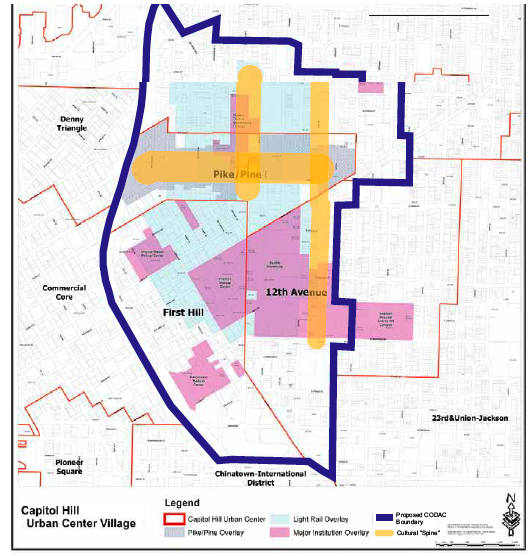 The proposed Capitol Hill CODAC boundary. Click for larger version.
The proposed Capitol Hill CODAC boundary. Click for larger version.
A step toward protecting — and growing — Capitol Hill’s arts will be taken tonight at the Century Ballroom. The venue hosts a special meeting of the City Council’s Culture, Civil Rights, Health and Personnel Committee to discuss the recommendations of a volunteer board convened to help make plans that preserve elements that foster creativity in Seattle and provide resources to grow those elements. In short, tonight’s meeting is about affordable space for artistic activities.
The Cultural Overlay District Advisory Committee (CODAC) says its goals are to:
Devise creative ideas for long-term promotion and preservation of cultural, arts, and entertainment activities and spaces in Seattle neighborhoods, then transform those ideas into recommendations the Council can consider implementing through ordinance and budget authority, beginning with Capitol Hill.
Tonight’s agenda includes a meet and greet with councilmembers starting at 5:30 PM followed by a public comment period, then the meeting with presentation of the committee’s recommendations. Presenters will be Fidelma McGinn, CODAC Co-Chair and Director of Artist Trust and Randy Engstrom, CODAC Co-Chair, Director of Youngstown Cultural Arts Center and Seattle Arts Commission member.
We’ve attached
a copy of the CODAC report they will be discussing. The group has formed six recommendations:
1. Allow for the creation of designated cultural districts within Seattle’s neighborhoods, to preserve and enhance space for arts and culture to thrive in local communities.
2. Allocate a staff position as a district cultural manager, to work specifically with cultural districts, and be a liaison with other City departments, community organizations, and cultural agencies.
3. Use existing City processes, such as incentives and regulations, and create and re-imagine these tools and processes under a cultural space ‘brand’. Regulatory relief, financial incentives, and land use incentives are the basic tools to be used.
4. Provide technical assistance to ensure the most effective use of these tools.
5. Conduct outreach and build awareness about how neighborhoods can provide arts and cultural space to encourage economic sustainability, express community identity, provide community building through participation in the arts and culture, and enhance overall quality of life.
6. Develop partnerships with organizations, foundations, government agencies, institutions, and individuals. Identify and pursue those potential partnerships with aligned goals, mutual support, and advocacy to achieve success.
The report describes the recommendations more fully and also has some interesting information about the arts environment on Capitol Hill including an index of nearly 200 “arts and culture-related spaces” on the Hill in section M of the report’s appendix.



